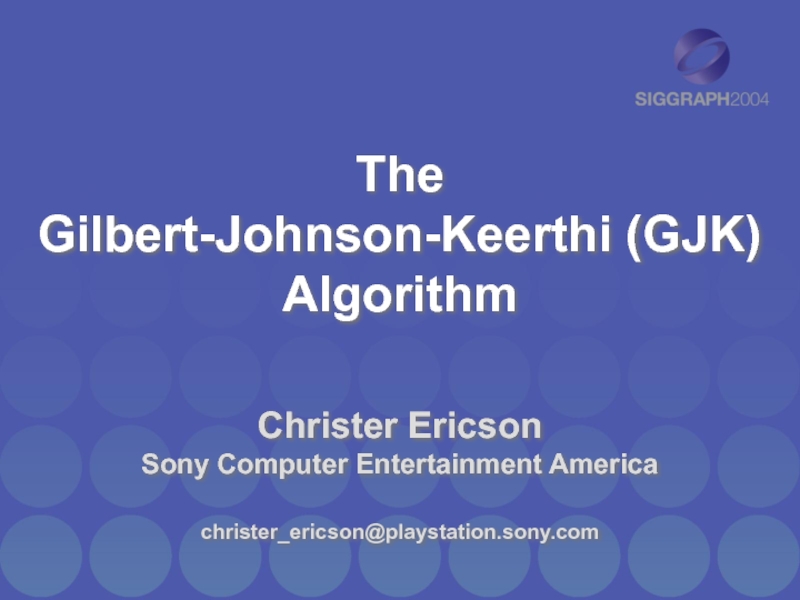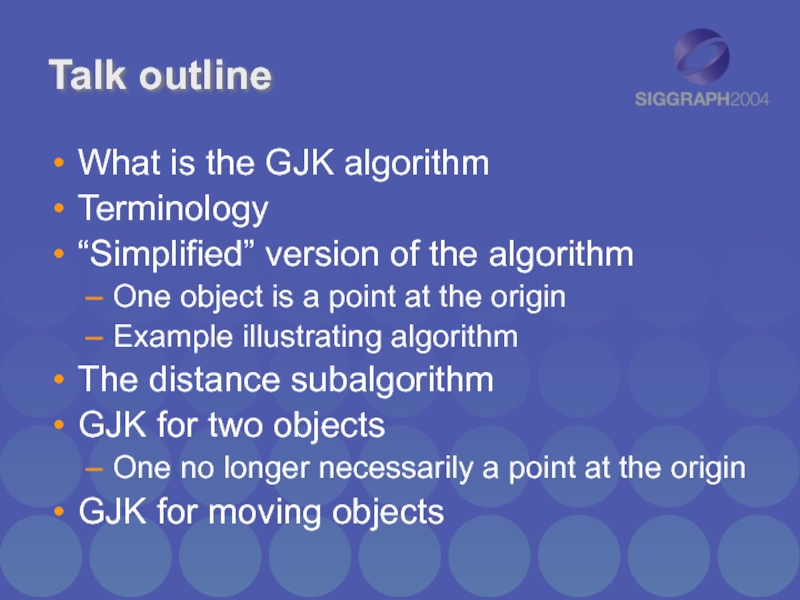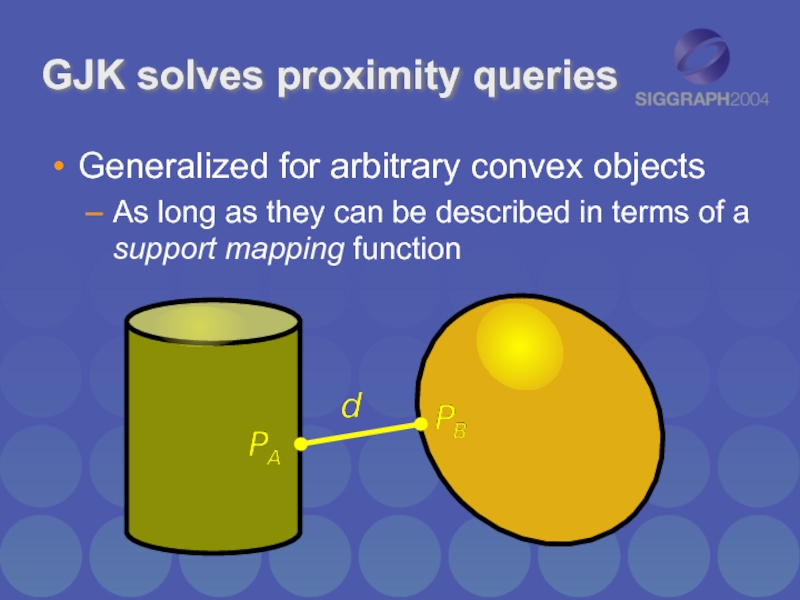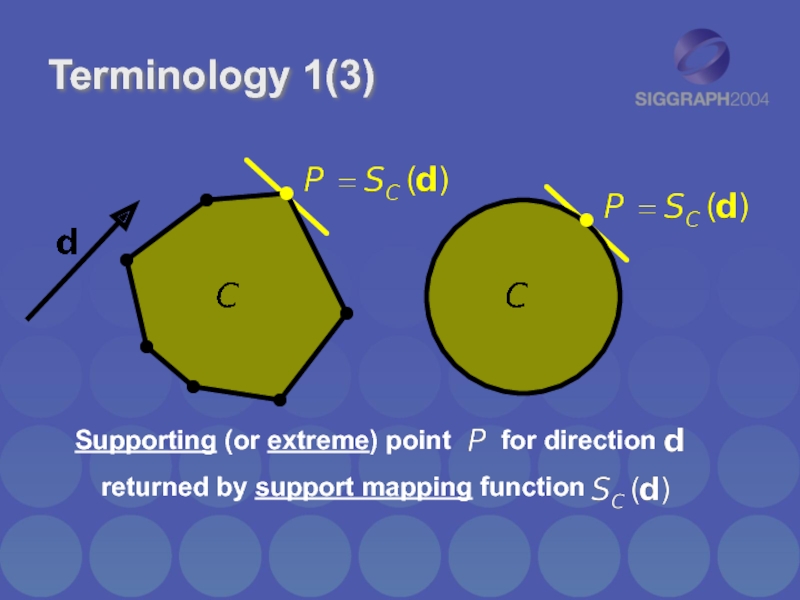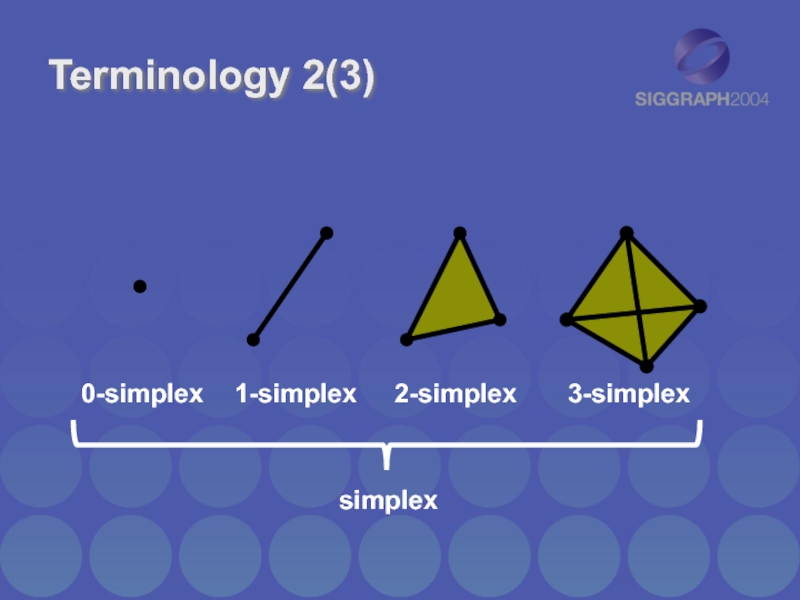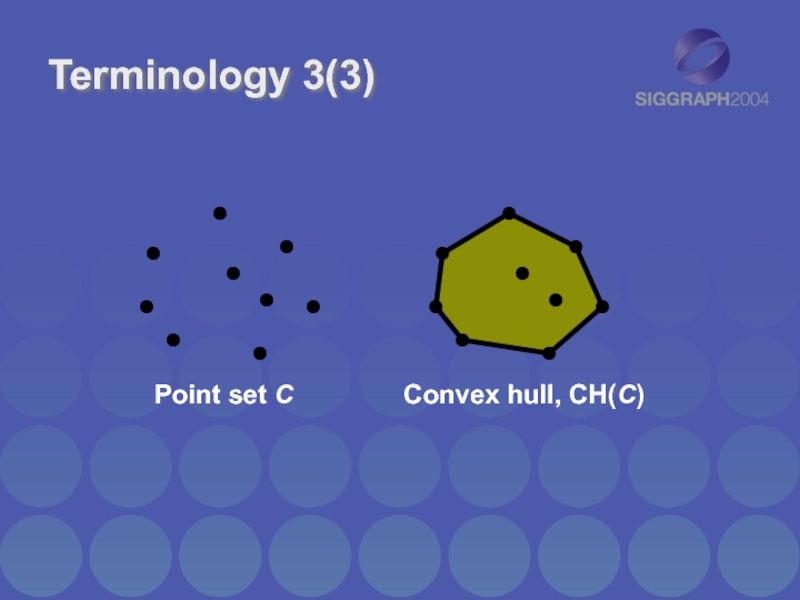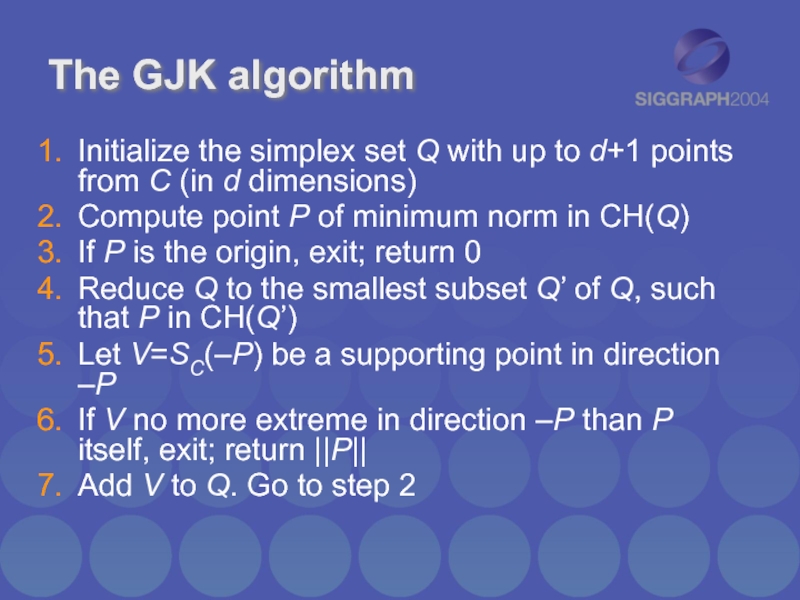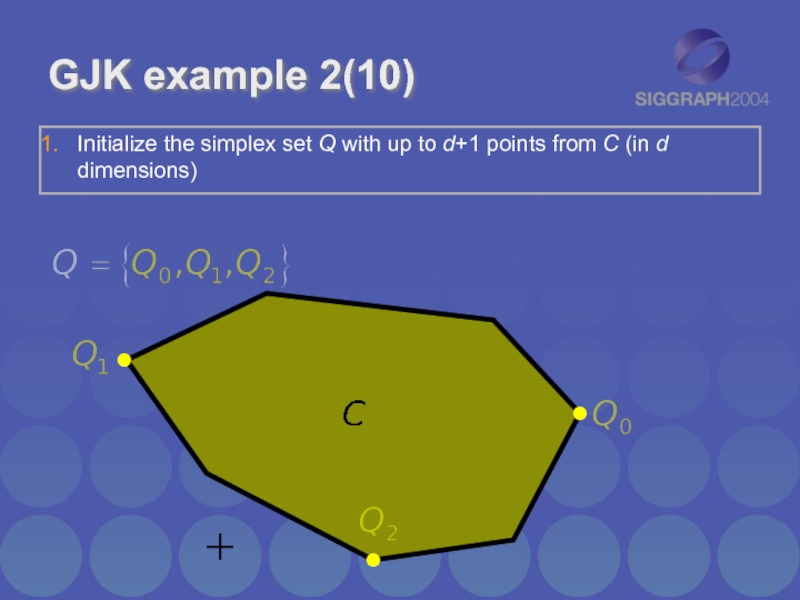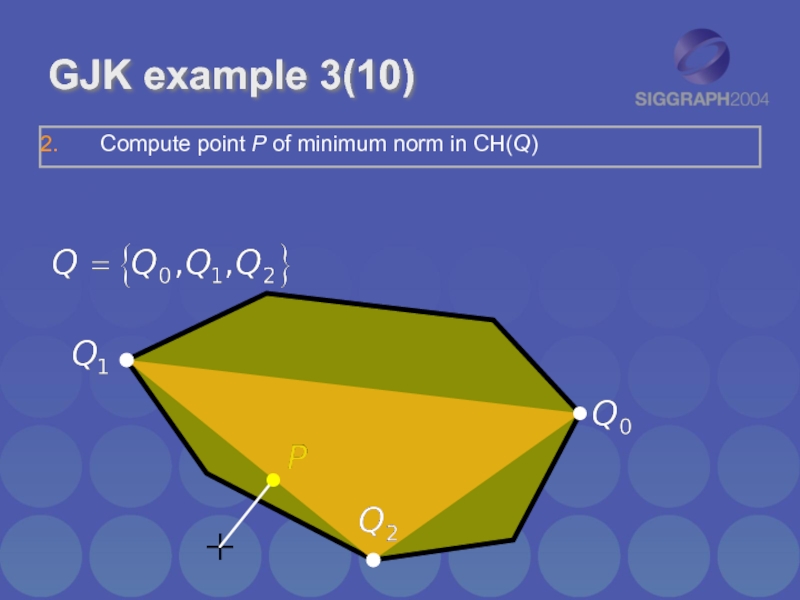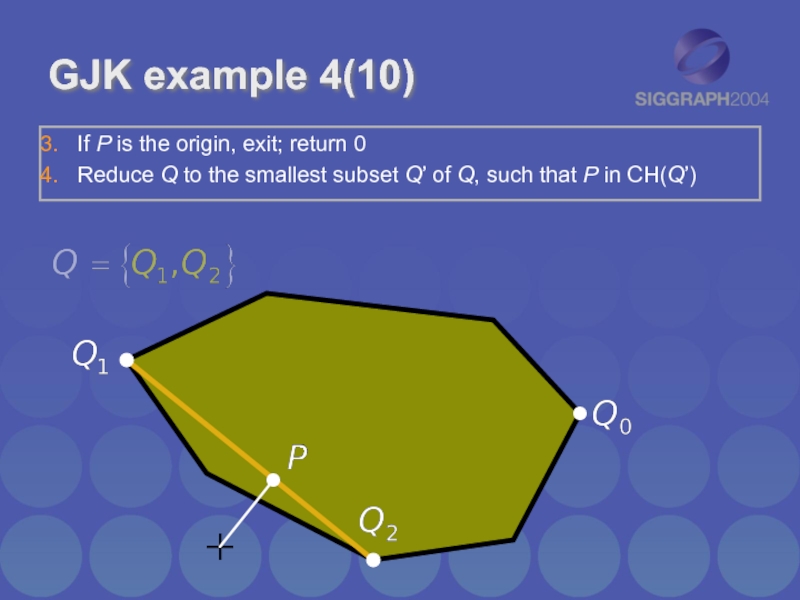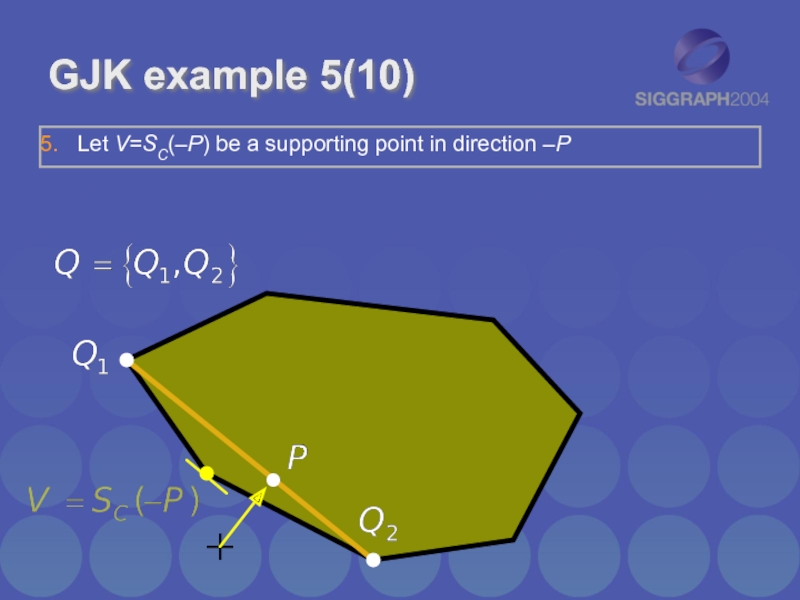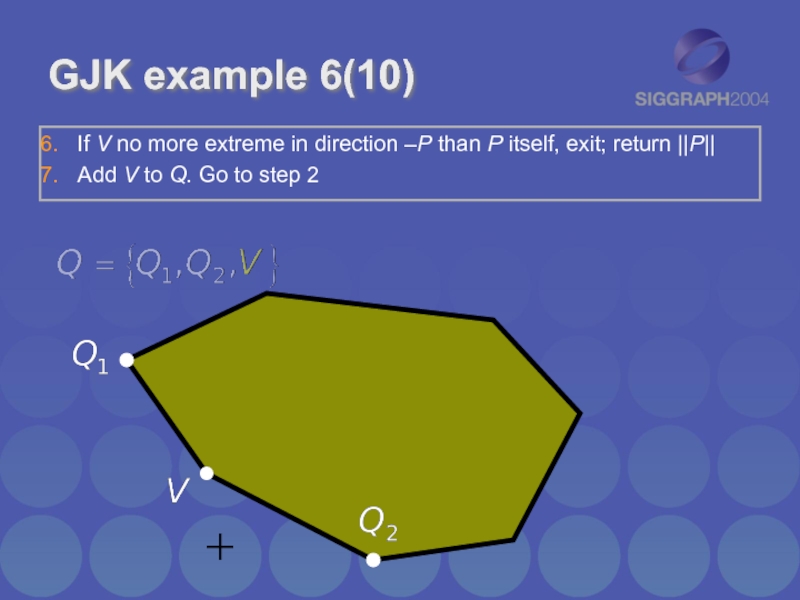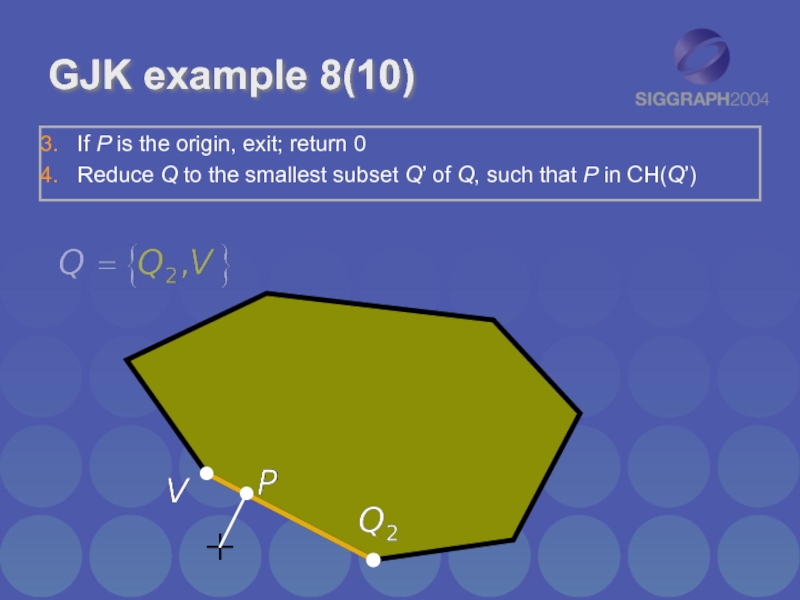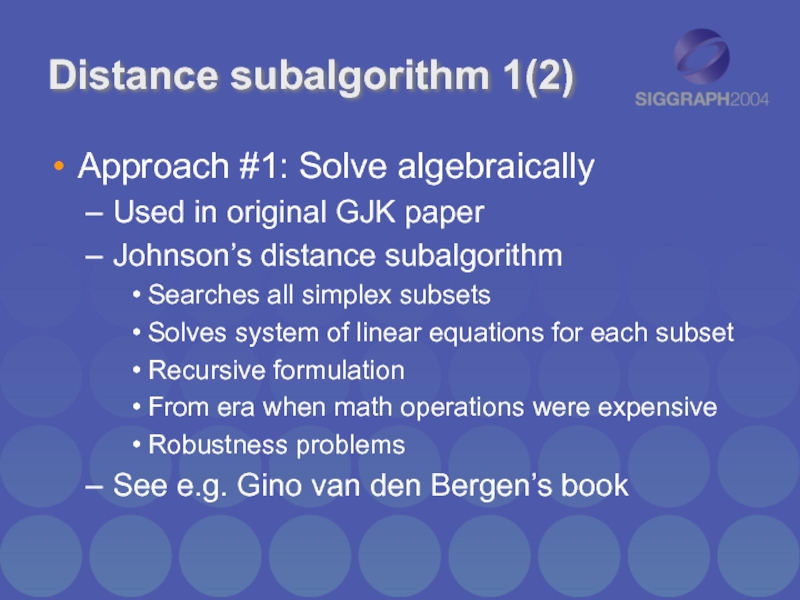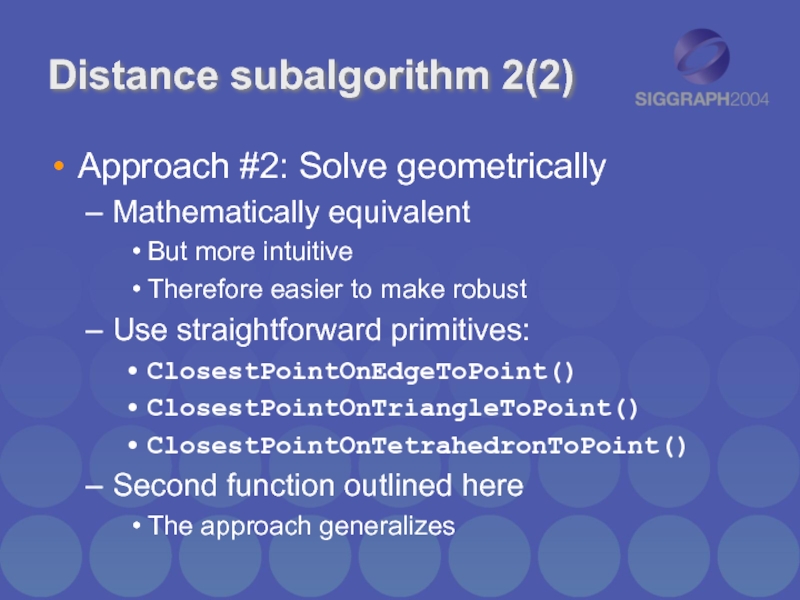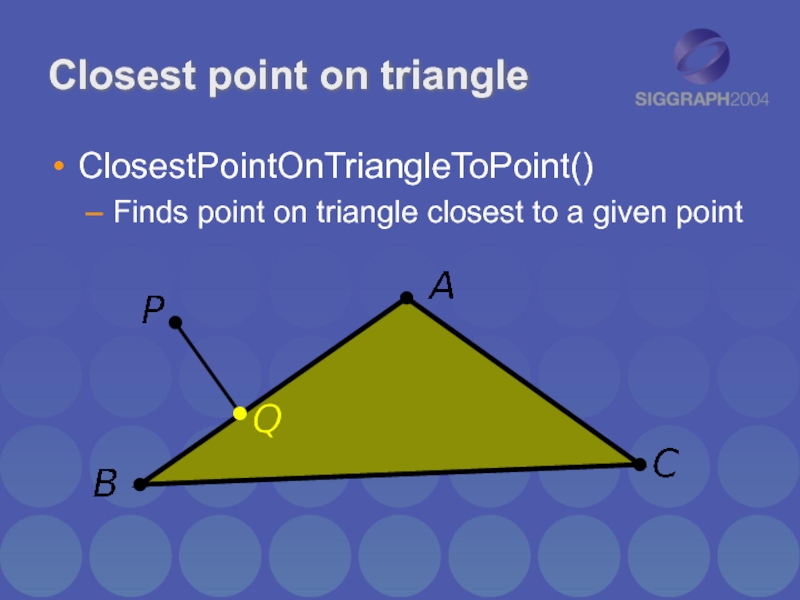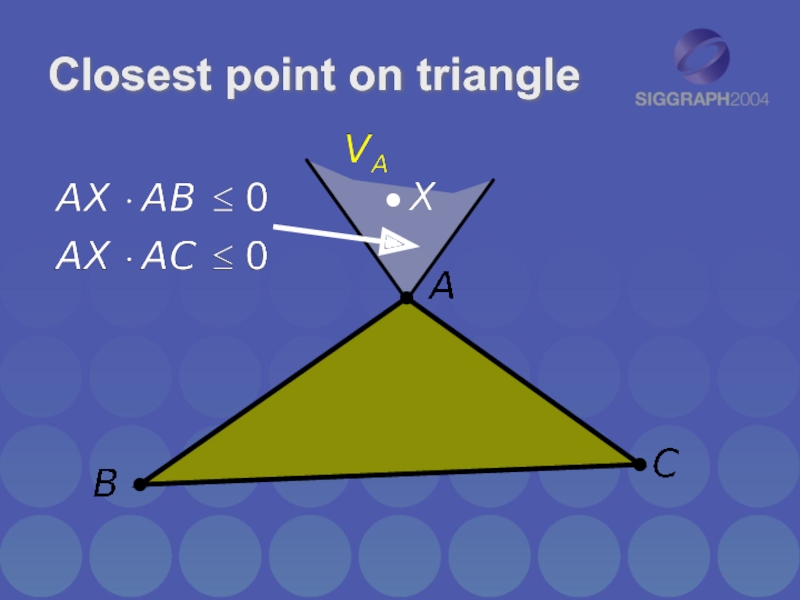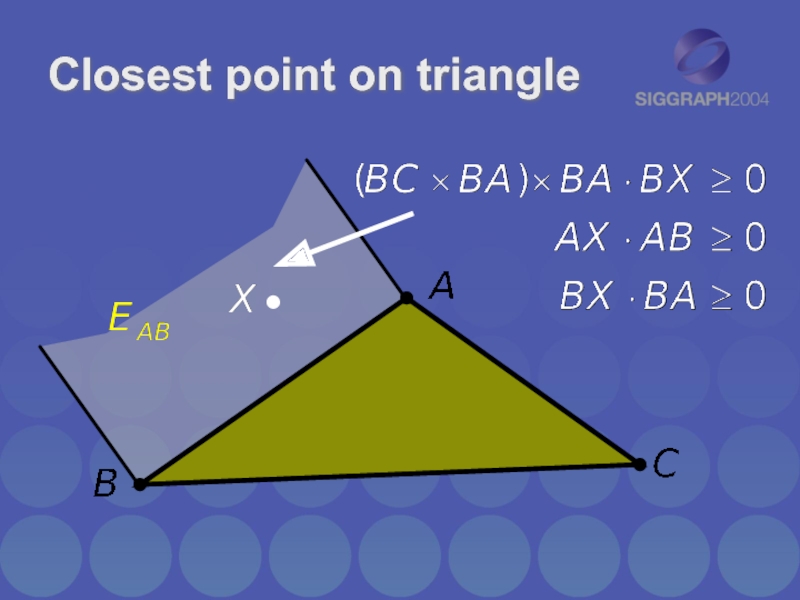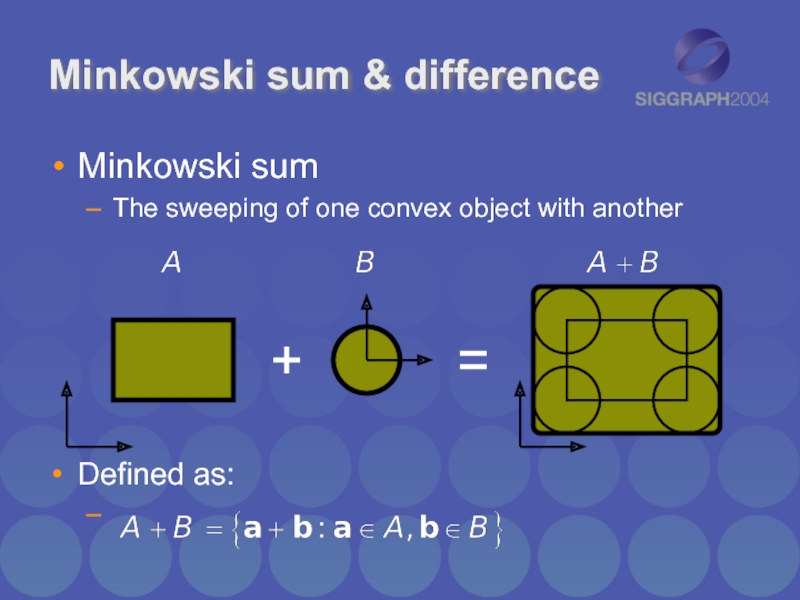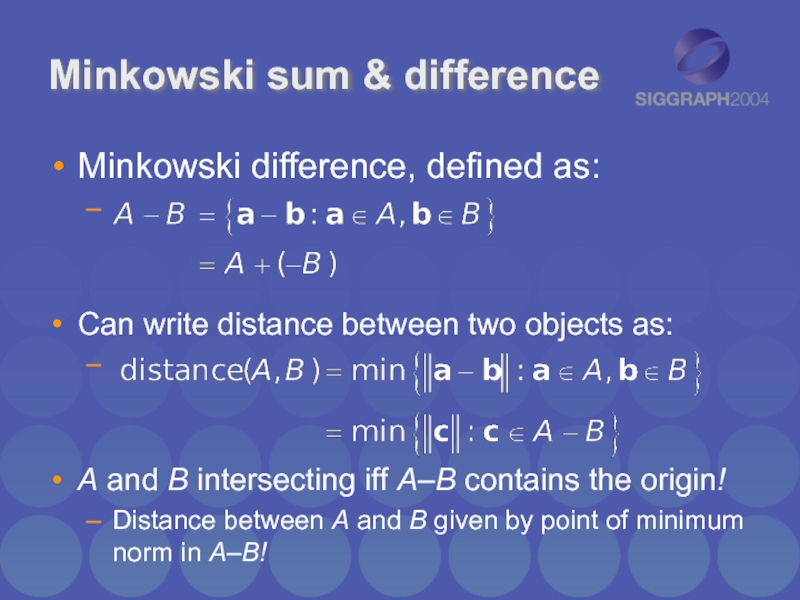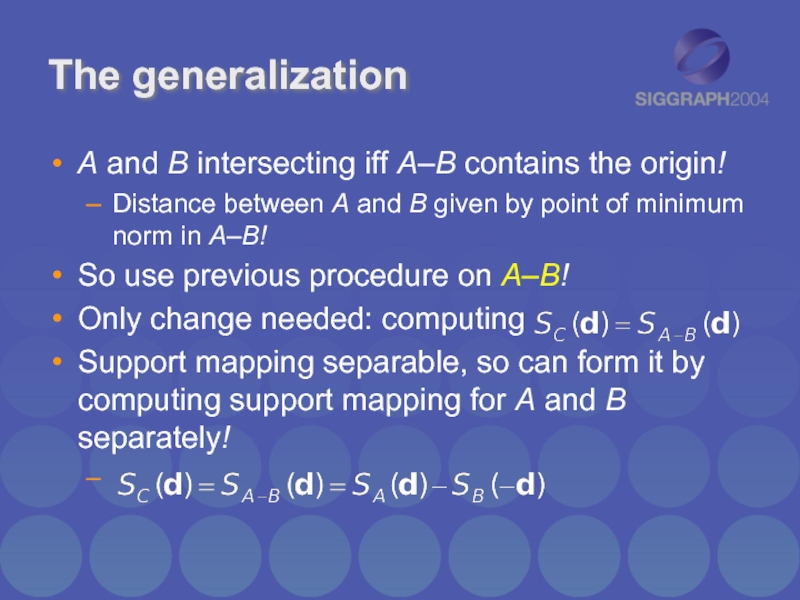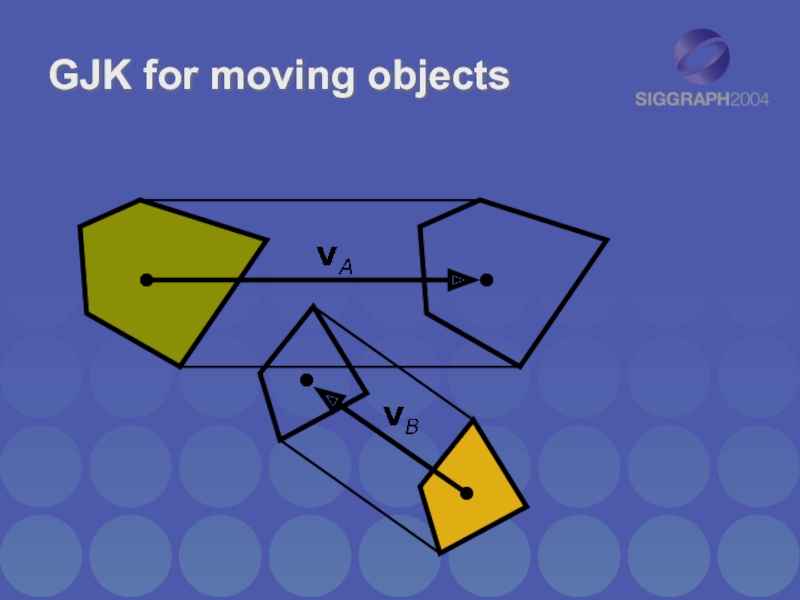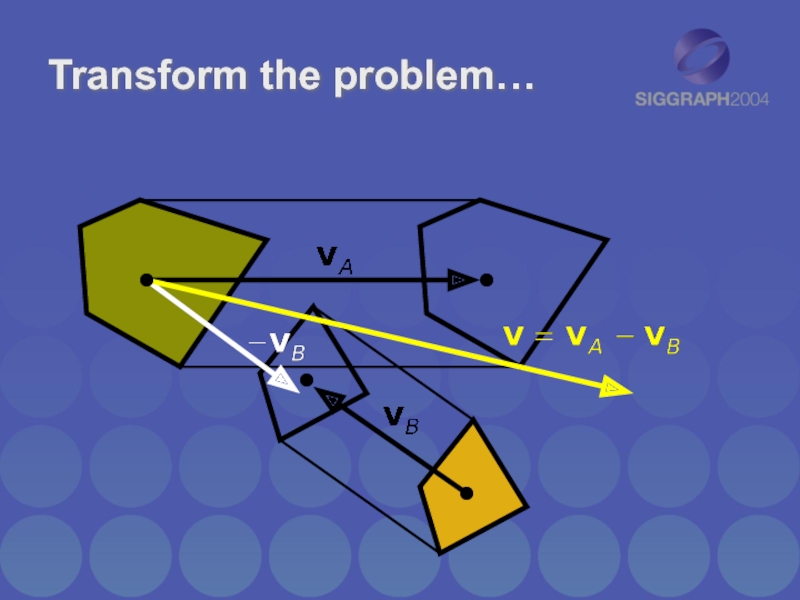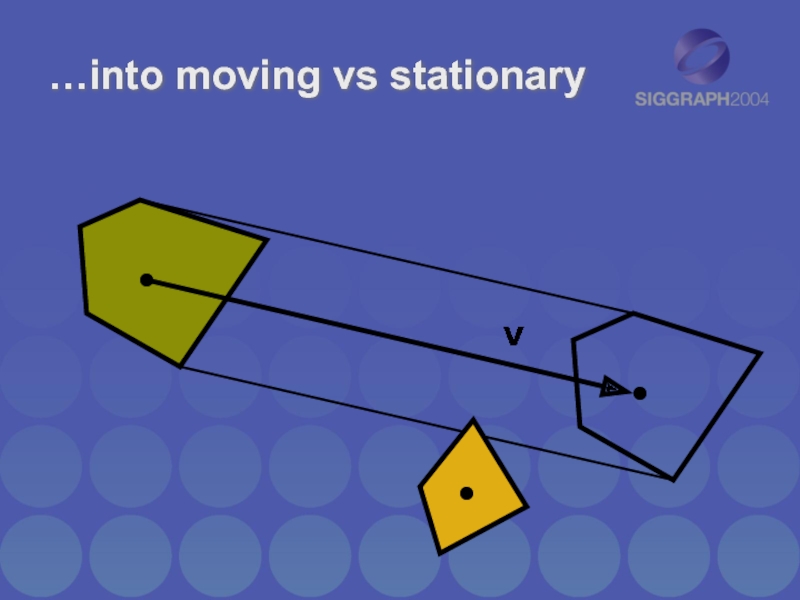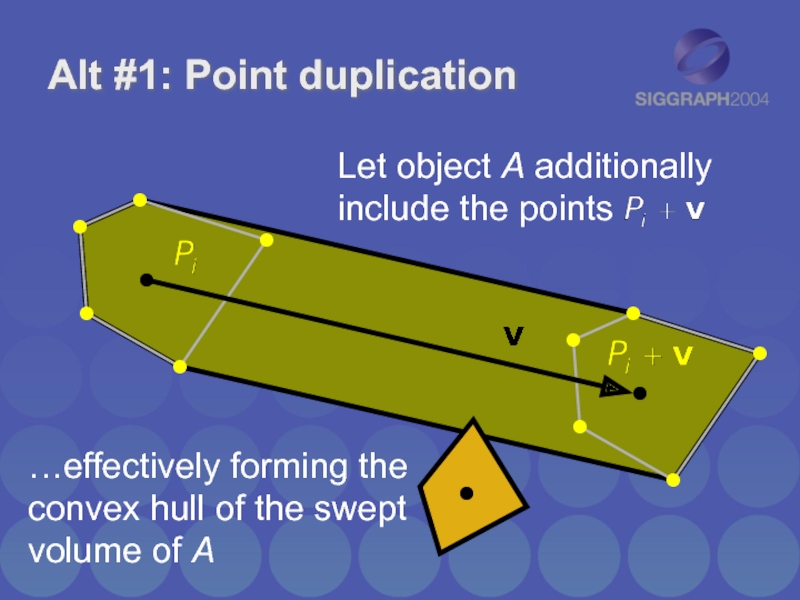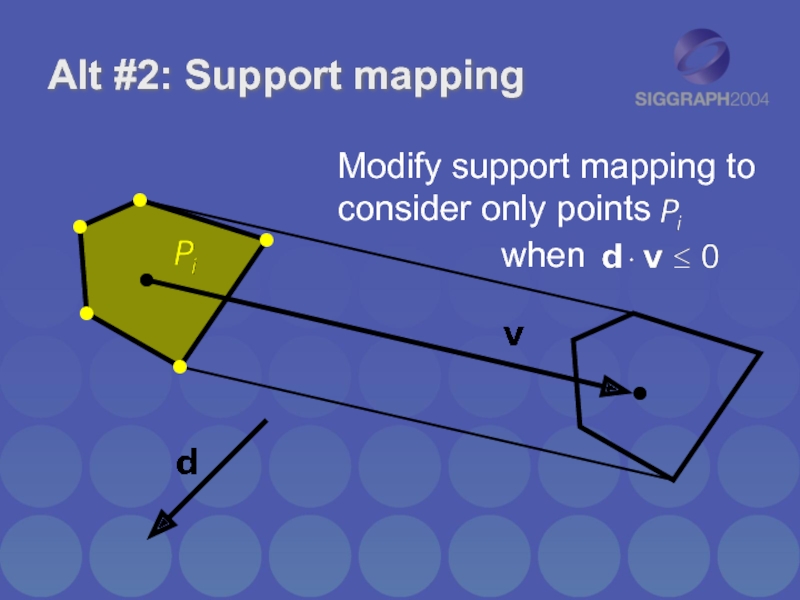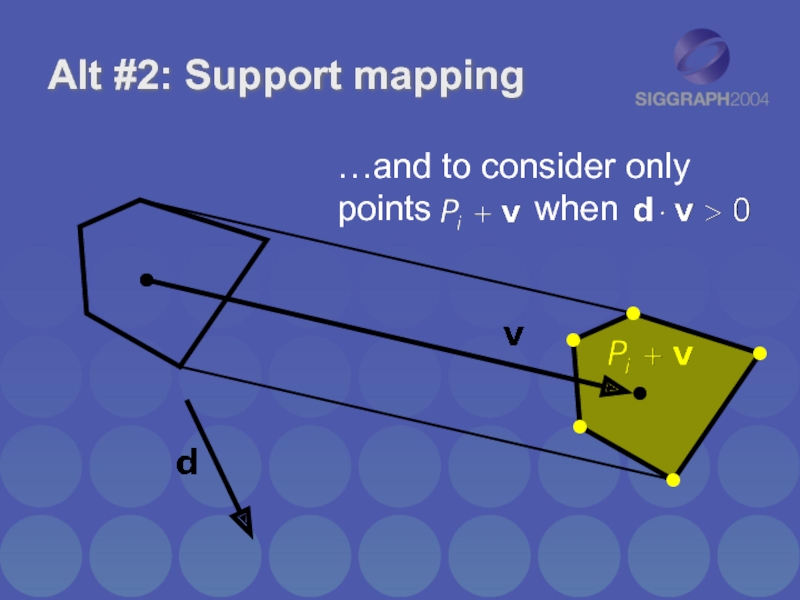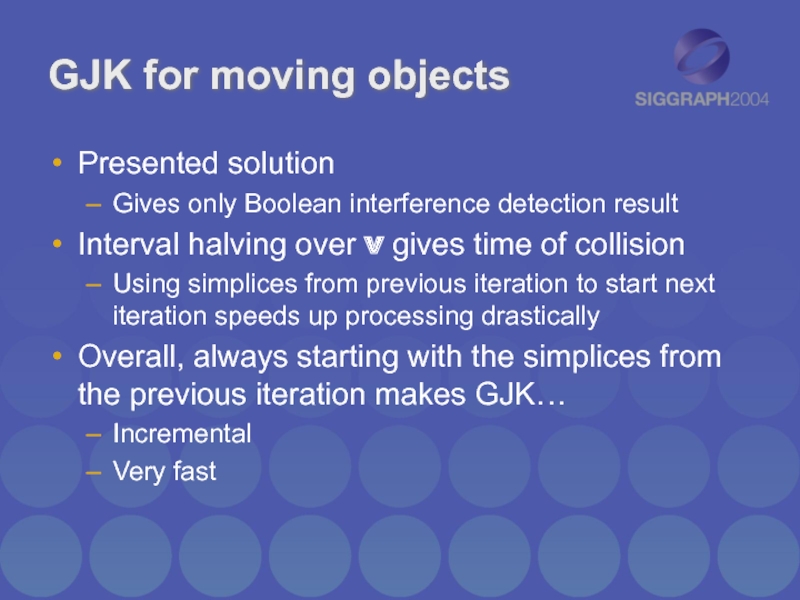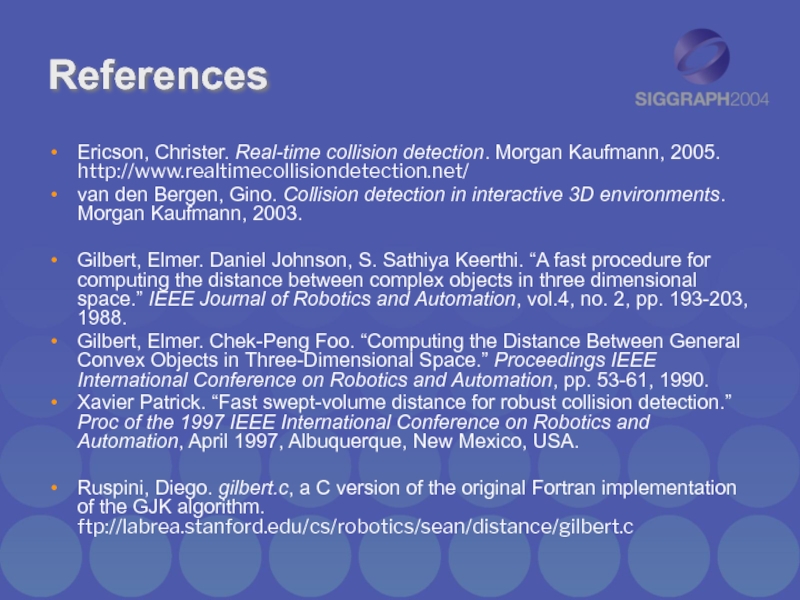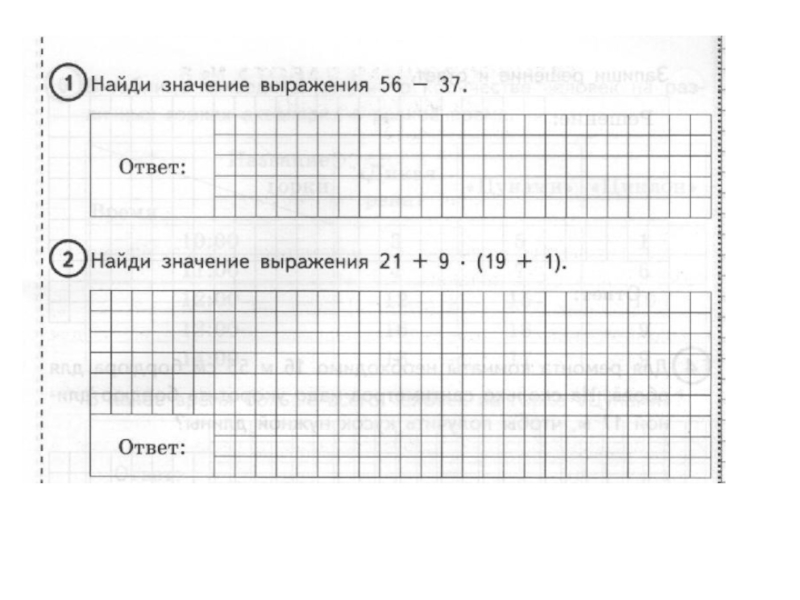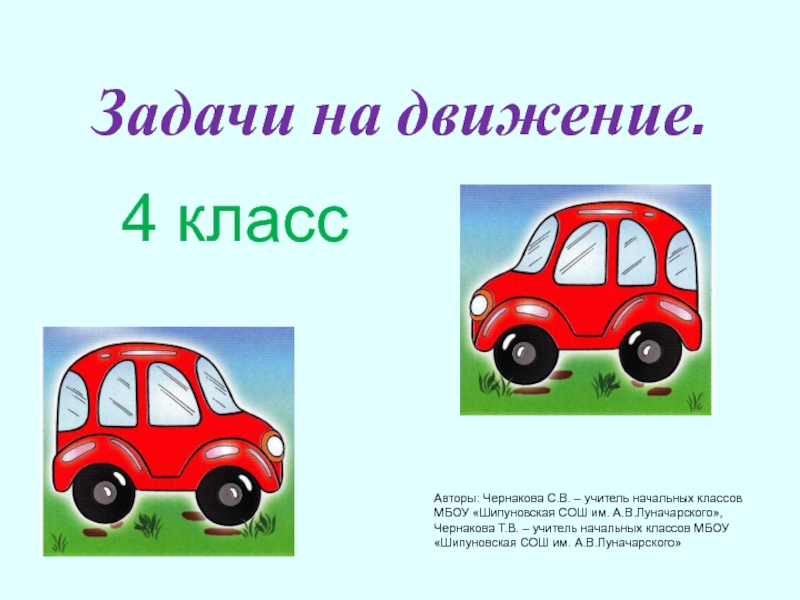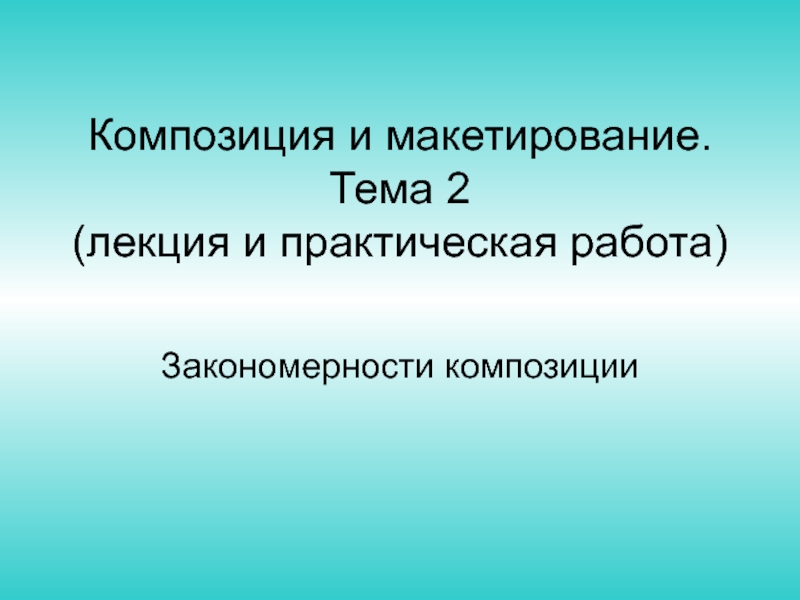- Главная
- Разное
- Дизайн
- Бизнес и предпринимательство
- Аналитика
- Образование
- Развлечения
- Красота и здоровье
- Финансы
- Государство
- Путешествия
- Спорт
- Недвижимость
- Армия
- Графика
- Культурология
- Еда и кулинария
- Лингвистика
- Английский язык
- Астрономия
- Алгебра
- Биология
- География
- Детские презентации
- Информатика
- История
- Литература
- Маркетинг
- Математика
- Медицина
- Менеджмент
- Музыка
- МХК
- Немецкий язык
- ОБЖ
- Обществознание
- Окружающий мир
- Педагогика
- Русский язык
- Технология
- Физика
- Философия
- Химия
- Шаблоны, картинки для презентаций
- Экология
- Экономика
- Юриспруденция
The Gilbert-Johnson-Keerthi (GJK) Algorithm презентация
Содержание
- 1. The Gilbert-Johnson-Keerthi (GJK) Algorithm
- 2. Talk outline What is the GJK algorithm
- 3. GJK solves proximity queries
- 4. GJK solves proximity queries
- 5. Terminology 1(3)
- 6. Terminology 2(3) 0-simplex 1-simplex 2-simplex 3-simplex
- 7. Terminology 3(3)
- 8. The GJK algorithm Initialize the simplex set
- 9. GJK example 1(10)
- 10. Initialize the simplex set Q with up
- 11. GJK example 3(10)
- 12. GJK example 4(10)
- 13. GJK example 5(10)
- 14. GJK example 6(10)
- 15. GJK example 7(10)
- 16. GJK example 8(10)
- 17. GJK example 9(10)
- 18. GJK example 10(10)
- 19. Distance subalgorithm 1(2) Approach #1: Solve algebraically
- 20. Distance subalgorithm 2(2) Approach #2: Solve geometrically
- 21. Closest point on triangle
- 23. Closest point on triangle
- 24. Closest point on triangle
- 25. GJK for two objects What about two
- 26. Minkowski sum & difference
- 27. Minkowski sum & difference Minkowski difference, defined
- 28. The generalization A and B intersecting iff
- 29. GJK for moving objects
- 30. Transform the problem…
- 31. …into moving vs stationary
- 33. Alt #2:
- 34. Alt #2:
- 35. GJK for moving objects Presented solution Gives
- 36. References Ericson, Christer. Real-time collision detection. Morgan
Слайд 1
The
Gilbert-Johnson-Keerthi (GJK)
Algorithm
Christer Ericson
Sony Computer Entertainment America
christer_ericson@playstation.sony.com
Слайд 2Talk outline
What is the GJK algorithm
Terminology
“Simplified” version of the algorithm
One object
is a point at the origin
Example illustrating algorithm
The distance subalgorithm
GJK for two objects
One no longer necessarily a point at the origin
GJK for moving objects
Example illustrating algorithm
The distance subalgorithm
GJK for two objects
One no longer necessarily a point at the origin
GJK for moving objects
Слайд 3GJK solves proximity queries
Given two convex polyhedra
Computes distance d
Can also return
closest pair of points PA, PB
Слайд 4
GJK solves proximity queries
Generalized for arbitrary convex objects
As long as they
can be described in terms of a support mapping function
Слайд 5
Terminology 1(3)
Supporting (or extreme) point
for direction
returned by support mapping function
Слайд 8The GJK algorithm
Initialize the simplex set Q with up to d+1
points from C (in d dimensions)
Compute point P of minimum norm in CH(Q)
If P is the origin, exit; return 0
Reduce Q to the smallest subset Q’ of Q, such that P in CH(Q’)
Let V=SC(–P) be a supporting point in direction –P
If V no more extreme in direction –P than P itself, exit; return ||P||
Add V to Q. Go to step 2
Compute point P of minimum norm in CH(Q)
If P is the origin, exit; return 0
Reduce Q to the smallest subset Q’ of Q, such that P in CH(Q’)
Let V=SC(–P) be a supporting point in direction –P
If V no more extreme in direction –P than P itself, exit; return ||P||
Add V to Q. Go to step 2
Слайд 10Initialize the simplex set Q with up to d+1 points from
C (in d dimensions)
GJK example 2(10)
Слайд 12GJK example 4(10)
If P is the origin, exit; return 0
Reduce Q
to the smallest subset Q’ of Q, such that P in CH(Q’)
Слайд 14
GJK example 6(10)
If V no more extreme in direction –P than
P itself, exit; return ||P||
Add V to Q. Go to step 2
Add V to Q. Go to step 2
Слайд 16GJK example 8(10)
If P is the origin, exit; return 0
Reduce Q
to the smallest subset Q’ of Q, such that P in CH(Q’)
Слайд 18
GJK example 10(10)
DONE!
If V no more extreme in direction –P than
P itself, exit; return ||P||
Слайд 19Distance subalgorithm 1(2)
Approach #1: Solve algebraically
Used in original GJK paper
Johnson’s distance
subalgorithm
Searches all simplex subsets
Solves system of linear equations for each subset
Recursive formulation
From era when math operations were expensive
Robustness problems
See e.g. Gino van den Bergen’s book
Searches all simplex subsets
Solves system of linear equations for each subset
Recursive formulation
From era when math operations were expensive
Robustness problems
See e.g. Gino van den Bergen’s book
Слайд 20Distance subalgorithm 2(2)
Approach #2: Solve geometrically
Mathematically equivalent
But more intuitive
Therefore easier to
make robust
Use straightforward primitives:
ClosestPointOnEdgeToPoint()
ClosestPointOnTriangleToPoint()
ClosestPointOnTetrahedronToPoint()
Second function outlined here
The approach generalizes
Use straightforward primitives:
ClosestPointOnEdgeToPoint()
ClosestPointOnTriangleToPoint()
ClosestPointOnTetrahedronToPoint()
Second function outlined here
The approach generalizes
Слайд 21
Closest point on triangle
ClosestPointOnTriangleToPoint()
Finds point on triangle closest to a given
point
Слайд 25GJK for two objects
What about two polyhedra, A and B?
Reduce problem
into the one solved
No change to the algorithm!
Relies on the properties of the Minkowski difference of A and B
Not enough time to go into full detail
Just a brief description
No change to the algorithm!
Relies on the properties of the Minkowski difference of A and B
Not enough time to go into full detail
Just a brief description
Слайд 26Minkowski sum & difference
Minkowski sum
The sweeping of one convex object with
another
Defined as:
Defined as:
Слайд 27Minkowski sum & difference
Minkowski difference, defined as:
Can write distance between
two objects as:
A and B intersecting iff A–B contains the origin!
Distance between A and B given by point of minimum norm in A–B!
A and B intersecting iff A–B contains the origin!
Distance between A and B given by point of minimum norm in A–B!
Слайд 28The generalization
A and B intersecting iff A–B contains the origin!
Distance between
A and B given by point of minimum norm in A–B!
So use previous procedure on A–B!
Only change needed: computing
Support mapping separable, so can form it by computing support mapping for A and B separately!
So use previous procedure on A–B!
Only change needed: computing
Support mapping separable, so can form it by computing support mapping for A and B separately!
Слайд 32
Alt #1: Point duplication
Let object A additionally include the points
…effectively forming
the convex hull of the swept volume of A
Слайд 35GJK for moving objects
Presented solution
Gives only Boolean interference detection result
Interval halving
over v gives time of collision
Using simplices from previous iteration to start next iteration speeds up processing drastically
Overall, always starting with the simplices from the previous iteration makes GJK…
Incremental
Very fast
Using simplices from previous iteration to start next iteration speeds up processing drastically
Overall, always starting with the simplices from the previous iteration makes GJK…
Incremental
Very fast
Слайд 36References
Ericson, Christer. Real-time collision detection. Morgan Kaufmann, 2005. http://www.realtimecollisiondetection.net/
van den Bergen,
Gino. Collision detection in interactive 3D environments. Morgan Kaufmann, 2003.
Gilbert, Elmer. Daniel Johnson, S. Sathiya Keerthi. “A fast procedure for computing the distance between complex objects in three dimensional space.” IEEE Journal of Robotics and Automation, vol.4, no. 2, pp. 193-203, 1988.
Gilbert, Elmer. Chek-Peng Foo. “Computing the Distance Between General Convex Objects in Three-Dimensional Space.” Proceedings IEEE International Conference on Robotics and Automation, pp. 53-61, 1990.
Xavier Patrick. “Fast swept-volume distance for robust collision detection.” Proc of the 1997 IEEE International Conference on Robotics and Automation, April 1997, Albuquerque, New Mexico, USA.
Ruspini, Diego. gilbert.c, a C version of the original Fortran implementation of the GJK algorithm. ftp://labrea.stanford.edu/cs/robotics/sean/distance/gilbert.c
Gilbert, Elmer. Daniel Johnson, S. Sathiya Keerthi. “A fast procedure for computing the distance between complex objects in three dimensional space.” IEEE Journal of Robotics and Automation, vol.4, no. 2, pp. 193-203, 1988.
Gilbert, Elmer. Chek-Peng Foo. “Computing the Distance Between General Convex Objects in Three-Dimensional Space.” Proceedings IEEE International Conference on Robotics and Automation, pp. 53-61, 1990.
Xavier Patrick. “Fast swept-volume distance for robust collision detection.” Proc of the 1997 IEEE International Conference on Robotics and Automation, April 1997, Albuquerque, New Mexico, USA.
Ruspini, Diego. gilbert.c, a C version of the original Fortran implementation of the GJK algorithm. ftp://labrea.stanford.edu/cs/robotics/sean/distance/gilbert.c
